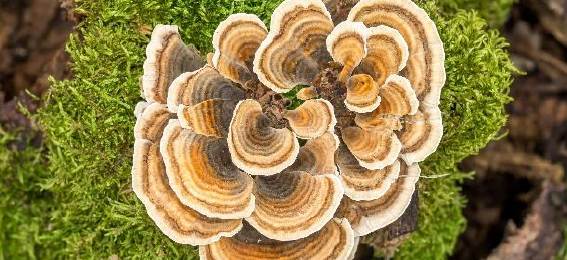
Turkey Tail Mushroom
Turkey Tail Mushroom (Trametes Versicolor) is one of the more common types of wild mushrooms. It grows abundantly in woodland and forests on hardwood logs or stumps.
As the name Versicolor suggests, the coloring varies. However, at their most vivid, the bright bands of color in the mushroom do somewhat resemble those in a turkey’s tail.
While the ecological importance of fungi has long been appreciated, and its medicinal use stretches back centuries, it’s only recently that the health benefits this specific mushroom may offer are getting serious scientific attention.
The History of Turkey Tail Mushroom
Turkey Tail Mushroom has been part of folklore remedies and a traditional diet in Asia for many centuries. It has especially been consumed as a tea, or decoction, and valued for its benefits for the liver, spleen, and lungs. It was utilized thanks to its perceived immune-boosting, anti-inflammatory, painkilling, antibacterial, and anticarcinogenic properties.
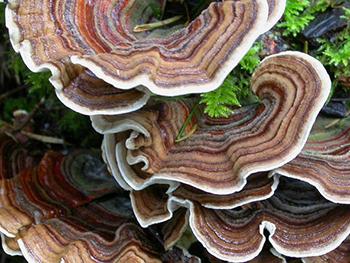
Chinese medicine specifically used Trametes Versicolor to treat liver infections and cancer, lung infections such as bronchitis, and rheumatoid arthritis. Both the Chinese and Japanese believe this fungus to be effective in combating a range of cancer types.
However, there are also records of this mushroom being used by healers in England, Finland, Mexico, and amongst the Aboriginal peoples of Australia who also used it to heal mouth sores.
Since the 1970s there has been a significant amount of research, particularly in Japan where it is an approved pharmaceutical-grade medicine, on the benefits of using Turkey Tail Mushroom as a cancer treatment and adjunct to chemotherapy.
Where It’s Found
Turkey Tail Mushroom is found throughout northern and mainland America, Europe, the UK, and Asia. Regardless of continent or region, this fungus can be found growing on dead and decaying tree stumps or logs. On the odd occasion tiers of these mushrooms are found on living trees.
The 10 Medicinal Seeds You Should Plant for a Complete Backyard Pharmacy (Video)
How to Identify Turkey Tail Mushroom
These mushrooms grow in tiered groups and each cap is thin and flexible when they are still fresh. Each cap:
- 2 – 8 centimeters / 0.78 – 3.12 inches across
- 1 – 2 millimeters / 0.04 – 0.08 inches thick
- May be fused with others
- Slightly convex or flat
- Semi-circular or fan-shaped in outline
- Whiteish inner flesh with a fine black line that is visible in cross-section.
The upper side of the cap
- The colors found in the upper side of Turkey Tail Mushroom vary considerably as they can be shades of browns, greys, greens, blues, purple, or orange.
- The colors occur in concentric zones or bands.
- The one aspect that does not change is that the wavy, outer edge of the cap is creamy white.
- The upper surface is also furry or velvety in texture thanks to the fine hairs, particularly in young mushrooms. Older caps will feel smoother.
The underside of the cap
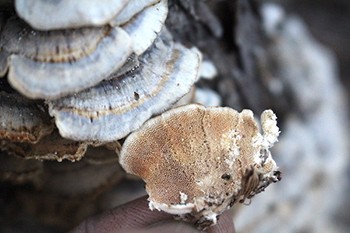
- Trametes Versicolor does not have a gilled underside but a pore surface. If you look very closely you should be able to spot the tiny spores.
- This side of the fungus is uniformly white or very pale brown and leathery and tough to the touch.
If a fungus does not meet these identifying features it is probably not Turkey Tail Mushroom…
How to Grow Turkey Tail Mushroom
If you wish to grow this fungus rather than foraging for it, you have two options: you can buy Spawn bags / a Grow Kit or you can buy Plug Spawn / inoculated dowels and obtain suitable wood (stumps or logs). The latter is more work but closer to a natural habitat for the Turkey Tail Mushrooms.
Mushroom Grow Kit
A grow kit is particularly useful for people who only have indoor spaces as these are designed for indoor growth. The bag consists of hardwood sawdust that has been inoculated with Turkey Tail mycelium (which is the multicellular vegetative part of a fungus that develops into mushrooms).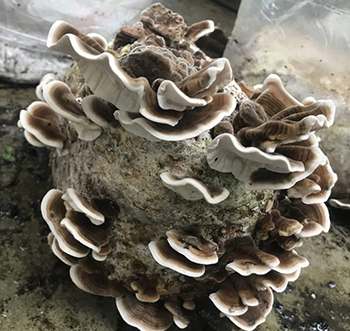
A good, active grow bag will white all over thanks to healthy and advanced mycelium growth. When the bag is ready, it must be placed in an area where there’s a lot of light but no direct sunlight. The bag shouldn’t be kept at temperatures higher than 750 Fahrenheit / 240 Celsius. The area must also be well ventilated so those in the property aren’t exposed to large numbers of spores.
You can allow the mushrooms to grow from the top in a rosette by cutting off the top 1 ½ inches / 4 centimeters of the bag, or from the sides of the bag by using a sharp knife to cut 2 or 3 slits in each side. The slits should be about 5 centimeters / 2 inches in length.
In either case, place a clear plastic bag over the top to create a humidity tent that has enough holes in it to allow air exchange but also to retain moisture and even temperature. The tent should be removed 2 to 6 times a day so that you can spray the interior of the tent with clean water and let fresh air in.
These mushrooms don’t grow fast so you won’t be able to harvest for 4 to 8 weeks.
Inoculated logs
The second option is to purchase either spawn (mycelium inoculated) sawdust or plugs/dowels as shown in the picture. The first is cheaper but the second is easier to use. Regardless of which you opt for, there are several steps you need to go through: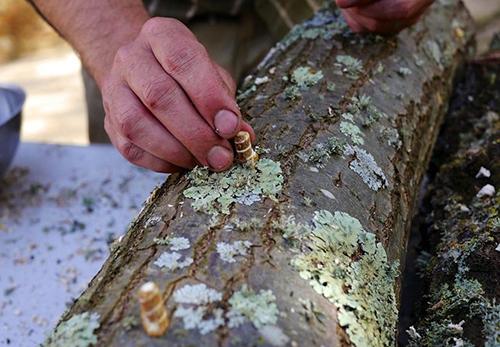
- Select timber: this can either be logs or tree stumps. If possible, pick up some fallen timber that has already begun to break down. Freshly cut wood won’t work as it still has immunity and will fight the fungus mycelium. Ideally, wood should be 3 – 6 inches / 7 ½ – 15 ¼ centimeters in diameter.
- Cut and clean the timber: brush off any lichen or moss and cut the wood into pieces that are 12 inches / 30 ½ centimeters in length.
- Drill: drill holes 3 inches / 7 ½ centimeters apart and no closer than 1 inch / 2 ½ centimeters from the ends. Don’t drill the holes in a straight line. The holes must be slightly deeper than the length of the dowel or plug you will be inserting.
- Inoculate the wood: insert the dowl or inoculated sawdust into the drilled holes. There must be a little space above the dowl or sawdust so the hole can be sealed.
- Seal the holes: you need to seal off the holes so that insects can get in and to prevent other unwanted fungi from spawning. The best option is beeswax. Melting it first and then applying it when it’s still soft – but not hot and liquid – is best. Don’t use any paraffin-based wax as fungal growth will be inhibited.
- Bury the wood: place the logs on top of a substrate such as a combination of soil, coil, vermiculite, or organic matter. Some people half bury logs in this layer.
- Water: keep the logs and substrate moist by watering them now and then.
Now you can simply wait for your mushroom crop to arrive.
How to Harvest Turkey Tail Mushroom
Regardless of whether you are foraging in the wild, or harvesting your own crop, only harvest fresh mushrooms: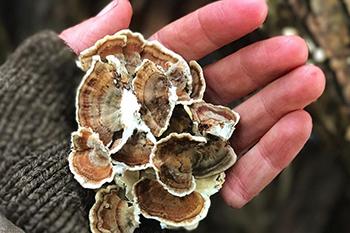
- they should still be growing
- the edge should still be white or pale
- the underside should still be white
- the underside should feel spongy.
To remove the mushrooms, gently twist them off or cut them off at the base.
Medicinal Seeds: Last Minute Deal
What Turkey Tail Mushroom is Good For And The Natural Remedies Made From it
The active ingredients in Turkey Tail Mushrooms that are particularly valuable – and increasingly the subject of clinical studies – are polysaccharides, proteins, and lipids. The two polysaccharide complexes in this fungus that are particularly noteworthy are polysaccharide K (PSK) and PSP.
The ingredients have powerful antioxidant properties that boost and strengthen the immune system, increase energy, and relieve pain. In addition, antimicrobial and antiviral actions have been established.
In preliminary studies, PSK specifically has shown strong anticarcinogenic abilities, particularly with colorectal cancers.
Viral and Bacterial Infections. Strengthening the immune system of HIV/AIDS patients, research has shown that turkey tail mushroom inhibits the binding of HIV to lymphocytes. Depletion of lymphocytes is the cause of the “acquired immunodeficiency” in AIDS. The mushroom also fights bacterial and viral infections. HPV, herpes, and shingles infections respond well to turkey tail when combined with reishi mushroom.
While turkey tail mushrooms are exceptionally nutritious and contain many vitamins and minerals, they are rarely eaten as they are hard to digest. To enjoy the full medicinal benefits, a double-extraction turkey tail tincture that uses only the fruiting body—like the one found in my Apothecary—is the most potent form.
What Parts of The Turkey Tail Mushroom Are Used in Remedies?
The whole mushroom is used for DIY remedies and manufactured preparations such as powder-filled capsules.
Related: Similar to Morphine: The Best Natural Painkiller that Grows in Your Backyard (Video)
A DIY Turkey Tail Mushroom recipe
Turkey Tail Mushroom is chewy and tasteless on its own. To overcome this, but obtain the health benefits this mushroom offers, it must be cooked a long time and have its flavor boosted with a few healthful ingredients. A popular way to enjoy Turkey Tail Mushroom is by making a decoction or tea.
Ingredients
- ¾ cup of chopped, dried Turkey Tail Mushrooms
- 4 cups of distilled or filtered water
Method
- Chop the mushrooms into small pieces

- Pour the water into a suitable pot or saucepan
- Add the mushrooms to the pot
- Bring the water to a boil

- Turn the heat down and simmer the mixture for about 1 hour
- If the water seems to be getting low, top it up
- Strain the mixture using a sieve, kitchen muslin, or cheesecloth

- Pour into a mug or a cup.

You could add peeled and chopped fresh ginger to the pot with the mushrooms if you wish to do so. Some people enjoy flavoring this tea with honey or lemon juice or adding non-dairy milk such as almond. Left-over tea can be refrigerated overnight and either enjoyed cold and reheated.
Dosage
It is thought that a cup of Turkey Tail Mushroom tea can be enjoyed daily. With extracts, powders, and capsules there are no consistent or standard clinical dosage recommendations that apply across the board. So, follow the use and dose directions on the packaging or follow the instructions given to you by your healthcare provider.
How to Preserve Turkey Tail Mushroom
There are several options when it comes to preserving this fungus for later use:
- Drying: chopped or whole mushrooms can be sundried, dried on a rack or cloth in a warm and well-ventilated area, or dried in a dehydrator. Regardless of the method, when the mushrooms are 100% dry, they can be stored in airtight containers.

- Powdering: dried mushrooms can be ground to powder and stored in airtight containers.
- Tincture: use >90% proof alcohol and mushrooms to make a tincture that will have a long shelf-life.

- Stock: make stock (the method is like the tea-making recipe but more concentrated as less water is used) and then freeze it in ice cube trays.
Regardless of which method or methods you decide on, you should have access to some form of Turkey Tail Mushroom for many of the months that the fungus is not in season.
What Resembles Turkey Tail Mushroom?
There are several bracket mushrooms that look like Turkey Tail. However, there are some helpful distinguishing features:
| Feature | Trametes VersicolorTurkey Tail | Trametes Pubescens(no common name) | Trametes OchraceaOchre Bracket | Trametes HirsutaHairy Bracket / False Turkey Tail |
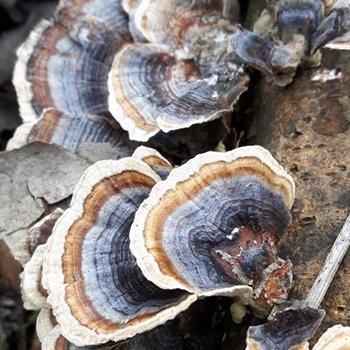 |
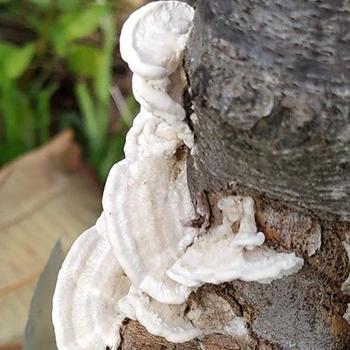 |
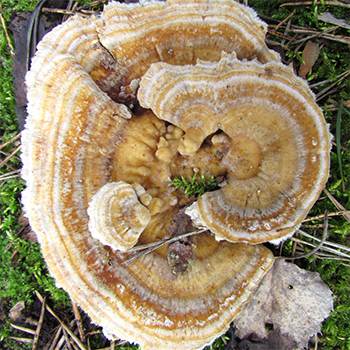 |
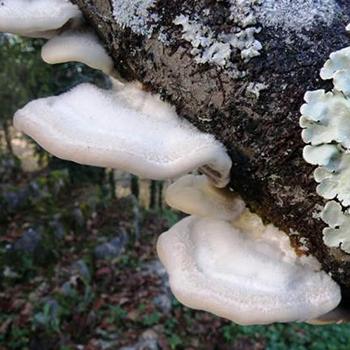 | |
| Growth | Tiered | Tiered | Tiered | Tiered |
| Cap size | 2–8 cm / 0.78– 3.12” across; 1– 2 mm / 0.04–0.08” thick | Maximum 8 cm / 3” across; maximum 5 cm / 2” deep | 1 ½ - 5 cm / 0.6 – 2” across | Maximum 10 cm / 4” across and 6 cm / 2 ½” deep |
| Cap shape | Fan; semicircle; slightly convex or flat | Semicircular; irregular | Semicircular; rosettes on horizontal surfaces | Semicircular; irregular bracket shape |
| Cap color | Widely varied; concentric, contrasting rings | Lacks strong color contrasts; whites, creams | Shades of brown, ochre, orange; concentric rings | White and gray; concentric zones of texture |
| Rim/edge | White / cream; wavy | White; wavy; thickened | White; uneven, slightly furred | Brown, light brown or black |
| Upper surface | Furry / velvety in texture | Furry / velvety in texture; deep furrows | Downy | Very densely hairy |
| Underside | White; spore bearing pores | Yellowish; pores | Creamy ochre; roundish pores | Whitish becoming brown, grey, or yellow |
Fortunately, none of these are toxic. However, if you are not 100% sure that you have correctly identified a fungus, don’t eat it… ever!
Warning And Cautions
Turkey Tail Mushrooms are considered safe and not contraindicated with any type of medication. However: pregnant and breastfeeding women should avoid using Trametes Versicolor as safety is not clearly established.
Studies indicate that some individuals may experience digestive symptoms such as bloating, gas, and dark stools. With higher, more long-term use some patients developed darkening of the fingernails.
As with any remedy/supplement – natural or not – check with your healthcare practitioner before you start using it, especially if you are on medication or drugs.
You may also like:
Herbal Coffee Substitutes You Can Drink Every Morning
The #1 Method to Help Support a Healthy Prostate (Video)
15 Things You Could Forage in Winter
How to Make Medicinal Kombucha at Home
How Long Do Dried Herbs, Ointments, Syrups, and Tinctures Last?






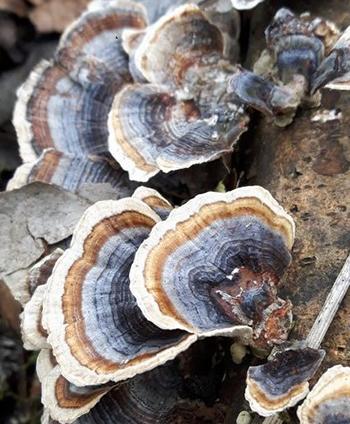
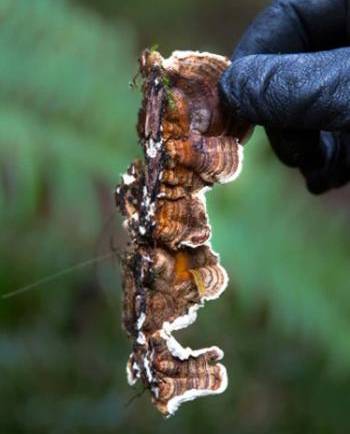
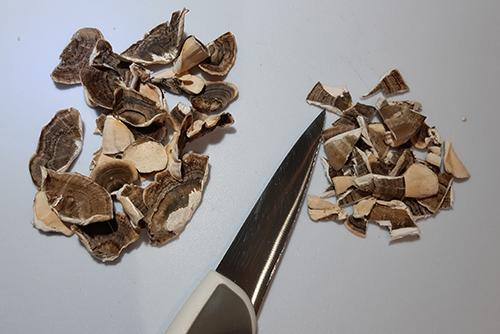
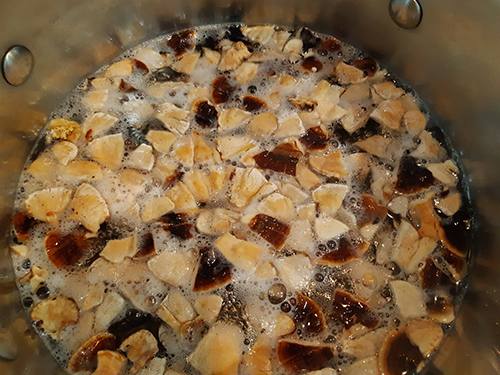

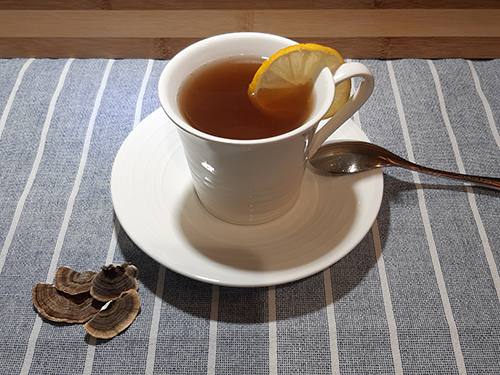

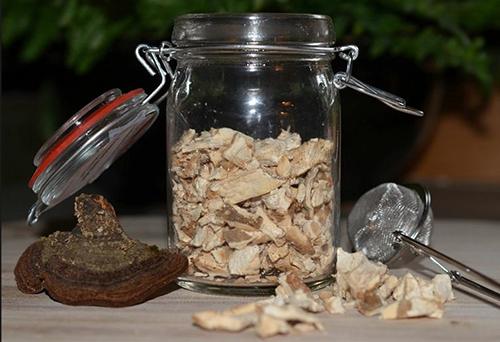


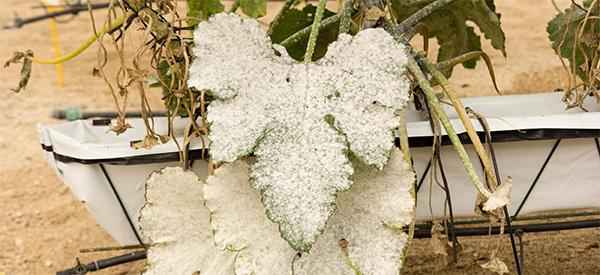
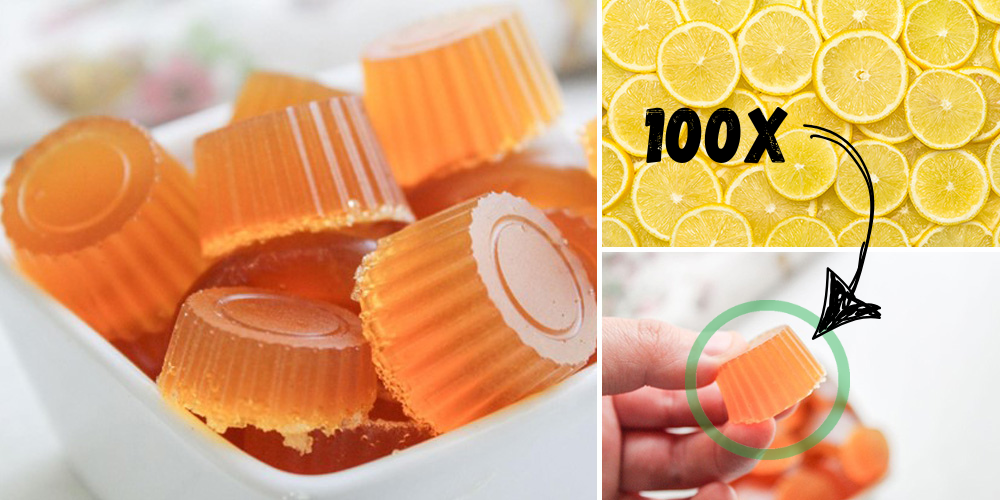
Super interesting. Thank you so much for sharing such inspiration
Hi Elizabeth,
Thank you for your feedback. We really appreciate it !
Great article!
Good to know, the area I usually work, I saw to many of those. Hope this year see it again.
Thank you for this information. I’ve seen several of these in the woods behind our home, but didn’t know they were safe. I’ll sure harvest them this year.
Is there a place we can buy these mushrooms already grown?
Hi Linda,
You can purchase online from Oregon Mushrooms:
https://www.oregonmushrooms.com/p-357-dried-turkey-tail-mushrooms.aspx
Or Etsy: https://www.etsy.com/market/turkey_tail_mushroom
God bless!